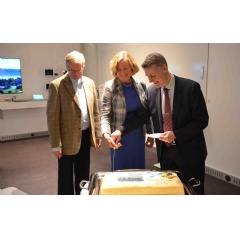Telenor’s research department digitising the world for 50 years
For the last 50 years, 900 researchers from Telenor Research have made their mark on the world’s technological development. The next 50 will be even more important, says Head of Telenor Research, Bjørn Taale Sandberg.
In 1967, the researchers in the newly established Telenor research department faced a challenge. How could they digitise the telecommunications network and make it possible for everyone in Norway to have a telephone?
The result was the complete digitisation of the fixed telephony network and pioneer work on mobile networks, both the Nordic standard NMT (1G), and the later international standard GSM (2G). Today, research is being done on 5G, artificial intelligence, the Internet of Things and big data.
SMS, Internet and YouTubeOver the past 50 years, Telenor’s research department has influenced digitisation. However, Bjørn Taale Sandberg, Research Director at Telenor stresses that partnership is key, and this has not been driven by Telenor alone.
– Science is, and should be, global. Good solutions come when results are shared across borders and research communities, and our researchers have made some significant contributions towards technological development over the last 50 years, says Sandberg.
In 1981, the Nordic Mobile Network (NMT) was launched as the first automated and commercialized mobile network service. Calls were for the first time automatically connected across the Nordics without depending on a human telephone operator. Having contributed to developing that system, Telenor Research were also influential in the making of the global standard, GSM, launched a little over a decade later.
In the GSM work, the researchers also contributed to the development of the Short Message System, SMS. The system was designed to notify users when they received a voice message, and even the international team that worked on SMS never saw the full potential of the technology. Today, we send billions of text messages every day.
More than mobileThe early years did not consist exclusively of research into mobile technologies.
– Most people do not know that Norway was among the first three countries in the world that had internet. The other two were the US and the United Kingdom. In the 80’s, Norway’s internet switch was only one button in the Telenor research department, and they studied things that are common today, such as search engines and internet sites. The Opera browser was a result of this, and eventually became a separate company, says Sandberg.
One of today’s most popular apps, YouTube, uses technology developed by Telenor’s research department, because algorithms made by the researchers are included in the MPEG4 video standard.
Berit Svendsen is now Head of Telenor in Scandinavia, but worked for Telenor Research for several years.
– To me, the years in the research department were an incredibly exciting period where we saw how big and important data communications would be for the industry and not least society. Going forward I believe science, together with the industry, will help solve many of the really big societal challenges in health, transportation and urban planning to name a few, says Svendsen.
5G, artificial intelligence and dengue feverToday, 45 researchers work within a broad field of topics in technology, social development and user habits. The results are used by the entire Telenor Group.
– Telenor Research is instrumental in our business development, both in Norway and globally. The researchers work on projects in all our business units and provide important insights and knowledge when we develop new products and services for our customers. At the same time, their efforts help the industry in stepping into future technologies and solutions, says Sigve Brekke, President and Chief Executive Officer at Telenor Group.
Telenor Research stays ahead of the game by working on topics long before they can materialise as services or standards.
– We are now studying the development of 5G and have been working on that for a while, even though 5G will probably not be commercialized until the 2020s. Other important areas for us are customer insights, analysis of Telenor’s big data sets, machine learning, organizational models, new technology and market dynamics, says Sandberg.
Telenor Research also aims to develop technologies with positive social impact. Together with Harvard University, they did a study in Pakistan in 2013, where anonymous and aggregated mobility data was used to predict the spread of dengue fever.
– The dengue study is an example of how researchers can use big data to solve social problems, Sandberg concludes.
The history of Telenor Research– 1967: The research institute is established with Dr Nic Knudtzon as Director and with a vision of digitising the network
– 1968: Satellite research initiated – basis for later television business in Telenor
– 1970: Researchers start digitalisation of landline networks and explore data communications
– 1981: Nordic mobile network (NMT), also known as 1G, is launched
– 1980: Early access to the predecessor of the web, researchers prepare for the future to come
– 1987: MPEG4 video standard algorithms developed, used by Youtube among others
– 1988: Research on how machines can understand sound and words
– 1980s: Telenor Research contribute to international research into the GSM standard
– 1990: Work on telemedicine began
– 1993: GSM standard, 2G, launched in Norway
– 1995: Televerket went from being a state owned monopoly to a public limited co. and changed name to Telenor
– 1995: Web browser Opera launched
– 1998: Research on users and user opinions is started
– 2000: Research on the Internet of Things begins with RFID technology
– 2010: Research on 5G begins
– 2013: Big data study on the spread of dengue fever in Pakistan with Harvard University
– 2017: Opening of the Artificial Intelligence Laboratory at NTNU in Trondheim and launch of Start-IoT initiative for Norwegian entrepreneurs and students
( Press Release Image: https://photos.webwire.com/prmedia/7/215844/215844-1.jpg )
WebWireID215844
This news content was configured by WebWire editorial staff. Linking is permitted.
News Release Distribution and Press Release Distribution Services Provided by WebWire.
